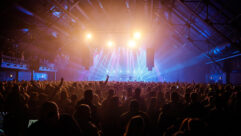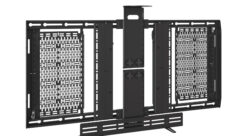
Club Attracts Talent With Sound System
A NIGHTCLUB that’s perfect for DJ shows may have a less-than-ideal setup for live performances, but that didn’t stop San Francisco’s Mezzanine club from trying to deliver both.
San Francisco’s Mezzanine club features two audio setups – a DJ rig that includes four floor stacks, each comprising four Funktion One Resolution 4 loudspeakers, a pair of F218 subs, and an Infrabass sub, and a live rig that contains two line arrays, each with six EAW KF730 loudspeakers, along with four SB1000 subwoofers under the stage.
CHALLENGE: Install reliable audio support worthy of A-list music talent in a DJ-oriented nightclub.
SOLUTION: Add stereo line arrays and a dance system powered by the same amps and processors, allowing the club to reorient the audio system for DJs or live shows by throwing a single switch.
A NIGHTCLUB that’s perfect for DJ shows may have a less-than-ideal setup for live performances, but that didn’t stop San Francisco’s Mezzanine club from trying to deliver both. After three years of dedicated effort to establish itself as a premier venue for DJ talent from around the world, the club wanted to start competing for top-name live acts.
The club’s first step was hiring production manager Josh Roberts, whose tour management resume includes names like Ben Harper, Beth Orton, King Crimson, and Meat Beat Manifesto. Roberts was happy with Mezzanine’s existing gear for DJ acts, but he immediately knew that a different setup would be required for live shows.
“We had a four-way Funktion One loudspeaker system that delivered great highs and lows for dance music, but they lacked the mid-range required for live concert sound,” Roberts says. “Besides, it’s unnatural to watch a band onstage and have sound coming from all around you. What we really needed was a left-right stereo setup that would deliver the proper imaging and coverage in the challenging space, but we didn’t want to replace all of the gear.”
An asymmetrical nightmare
With this challenge in mind, Roberts invited Mike Lacina, owner of San Francisco-based AV design and
Three QSC 6.0 Mklls, a pair of QSC 4.0s, and three QSC 2.0s provide amplification for the club’s audio rigs. Saved profiles on a pair of XTA DP226 processors allow the club’s technical staff to switch processor settings between DJ and live rigs as easily as switching the amps.
installation firm JK Sound, to tour Mezzanine. The room is shaped like a long, narrow shoebox with 18-foot-high ceilings and a mezzanine level that extends half the length of the side wall, and two-thirds of the back, overlooking the dance floor.
The main floor’s asymmetrical layout features a DJ platform and stage area located in the back left corner at a 20-degree angle at the intersection of the short, 60-foot back wall and the 100-foot side wall. Two bars, a coat check room, bathrooms, and a staircase are situated around the side and back walls.
“The club’s size and lack of symmetry posed serious challenges in loudspeaker system design,” Lacina says. “For starters, a left-right configuration of loudspeakers had to project a long way to the back wall without spilling excess energy on the side walls, which was challenging enough. But with the stage in the corner, the projection angles were a nightmare for all but the most highly directional loudspeakers.”
The need for predictable directionality led Lacina straight to EAW’s KF730 Series line array. “A nightclub isn’t the first place you’d think to install a line array system, but the KF730s are compact enough for the space, yet they deliver extraordinary SPL for their size,” Lacina says. “With their exceptional vertical and horizontal pattern control, we were able to get an even dispersion from the front to the back of the venue.”
Integration challenges
Once Lacina and Roberts identified the perfect loudspeaker solution, the next challenge was integrating it into the club’s existing system. “We knew the DJ and live rigs would never be used simultaneously,” Lacina says. “So I started thinking, ‘why can’t we use the same amps and processors for both rigs?’”
When Lacina asked JK Sound’s lead systems engineer Brad Katz to implement the idea, Katz laughed. “I’ve never heard of anybody crazy enough to use the same amps for two sets of FOH loudspeakers,” Katz says. “But I was intrigued by the challenge. I eventually designed a gigantic switch that allowed me to do exactly what Mike described.”
Katz’s switch, which Roberts nicknamed “The Contraption,” is a device more reminiscent of props from the set of Frankenstein than a modern audio system (see sidebar). The custom-built device uses 14 relays to map each amplifier channel to the appropriate device in either the DJ or the live rig.
THE FRANKENSTEIN FACTOR
The room’s asymmetrical layout affected the fly position for the new line arrays. Because the stage is located at a 20-degree angle, the design team fabricated its own 4×6 joists out of 2x4s for added strength, and used EAW’s Wizard modeling software to fine-tune the arrays at the necessary fly points.
Using the same amps and processors for two different loudspeaker rigs is tricky, but not impossible, according to JK Sound’s lead systems engineer Brad Katz.
It helped that both loudspeaker systems had the same number of devices — 12 — and that the QSC amps driving the existing Funktion One system were also suitable for the new EAW KF730 line arrays and SB1000 subwoofers.
Using only a spreadsheet and manufacturer specifications for every piece of gear, Katz mapped out the acceptable impedance loads for the loudspeaker systems. Where each of the two EAW KF730 line arrays used three high and three low amp channels, the four Funktion One Resolution 4 floor stacks each required stereo high/mid, low, sub, and supersub amp channels. By comparing charts for both loudspeaker systems, Katz was able to identify the exact EAW and Funktion One device that every given amp channel would power.
Katz designed a switch around 14 Omron 24-V, 30-amp, dual-pole, dual throw relays and 12-gauge wiring. Housed in a low-voltage electrical box, the rustic switch makes Mezzanine production manager Josh Roberts think of Dr. Frankenstein when he changes setups from DJ to live. Flipping the switch turns on the power amps, simultaneously switching all of the relays.
As for processing, Katz fine-tuned the existing Funktion One settings on the twin XTA DP226 processors, saving it as a DJ event profile. For the new line arrays providing FOH audio for live shows, Katz perfected processing based on nearfield, midfield, and farfield driver projection.
“Rather than simple stereo processing for the highs/mids and lows, we achieved a smooth frequency curve throughout the long, narrow space with three different EQs in each array,” he says. “This projects the highs/mids clear and strong all the way to the back of the room, while taming the nearfield. The different EQs were devised with the use of SIA’s Smaart system (Earthworks M-30 mic, Dell laptop running the Smaart program, and a Sounds Devices USB-Pre for a sound card) measuring the room interaction at three different distances, then listening and tweaking the results for smoothness to the human ear.”
The DJ rig includes four floor stacks, each comprising four Funktion One Resolution 4 loudspeakers, a pair of F218 subs, and an Infrabass sub. The live rig contains two line arrays, each with six EAW KF730 loudspeakers, along with four EAW SB1000 subwoofers installed under the stage. Amplification for both rigs is provided by three QSC 6.0 MkIIs, a pair of QSC 4.0s, and three QSC 2.0s. Finally, saved profiles on a pair of XTA DP226 processors allow the club’s technical staff to switch processor settings between DJ and live rigs as easily as switching the amps.
After proving the unique strategy could work, the next step was to identify the perfect fly position for the new line arrays. Once again, the room’s asymmetrical layout was a challenge. “Mezzanine’s stage isn’t just in the corner — it’s at a 20-degree angle,” Katz says. “So, instead of flying the arrays from the existing grid of beams and joists on the ceiling, we had to fabricate our own 4×6 joists out of 2x4s for strength.”
As for placing the new joist, “We were using laser measurements, complex mathematics, and even a cardboard mockup of the KF730s with fly brackets just to get the fly points exactly right, as the right stack ends up 4 inches from the Resolution 4 array on that side,” Katz says. “In the end, EAW’s Wizard modeling software helped us fine-tune the line arrays at the necessary fly points, and even helped us compensate for a troublesome concrete beam that was 10 feet from the right stack.”
Isolating the subs
Lacina and Roberts wanted to install one KF730 Series line array on each side of the stage, augmented by four EAW SB1000 subwoofers under the stage. “If you’re going to unleash the energy of four double 1,000 W subwoofers under a hardwood stage, you have no choice but to contain each one acoustically,” Lacina says. “Otherwise, stage vibrations would rattle the performers and all of the gear on stage — drowning out much of the low-end energy and muddying up the sound.”
Isolating the subs in concrete was out of the question, given the structural impact on the security firm located underneath the club. Instead, Lacina spent a very small fortune in QuietRock, a sheetrock substitute known for its superior noise rejection. “QuietRock costs more than 10 times as much as sheetrock,” he says. “However, it only took eight pieces for our project, so it was a fairly nominal expense.”
For each of the four subwoofers, Lacina designed a double-layer enclosure surrounding all but the front of each cabinet, with four Mason neoprene W-pads (2- by 2- by 3/4-inches thick) underneath each one to eliminate resonance pockets. Finally, the enclosures were filled with about 4 inches of mineral fiber insulation around the cabinets, chosen for its ability to absorb energy and decrease resonance.
Double the value
JK Sound’s unique approach to adding live show support has yielded two major benefits. First, the entire project cost just less than $100,000. “A duplicate set of amps and processors would have easily cost $35,000,” Lacina says. “The ‘Contraption,’ on the other hand, mostly just taxed Brad’s brain power, so the savings were very significant.”
FOR MORE INFORMATION
- EAWwww.eaw.com
- Funktion Onewww.funktion-one.com
- Mason Industrieswww.mason-ind.com
- QSCwww.qscaudio.com
- Quiet Solutionwww.quietsolution.com
- XTAwww.xta.co.uk
More importantly, the system yielded two sound systems of uncompromising quality, both of which make the club sound better than ever. Lacina says the extensive planning behind the line array system paid off. “We’re amazed with the coverage we achieved for the live rig,” he says. “From the front edge of the stage all the way to the mix position at the back of the room, the PA delivers even, clear coverage. There are lots of venues in San Francisco with great sound, but I think Mezzanine is the only one where there’s such uniform coverage throughout the main floor.”
But for Mezzanine, the most dramatic impact has been the satisfaction of the artists. “We’ve hosted top live talent like Mos Def, Alpha Blondi, The National, Michael Franti, and Ozomotli, and they couldn’t be happier with Mezzanine,” Roberts says. “In fact, some have even taken the unusual step of calling their national booking agents to praise Mezzanine’s sound quality for future reference. That’s exactly the result we wanted to ensure Mezzanine’s position to attract the hottest talent, which in turn assures the success of a truly great club.”
Meg Muran is a Seattle-area freelance writer covering the AV industry. She can be reached at [email protected].










